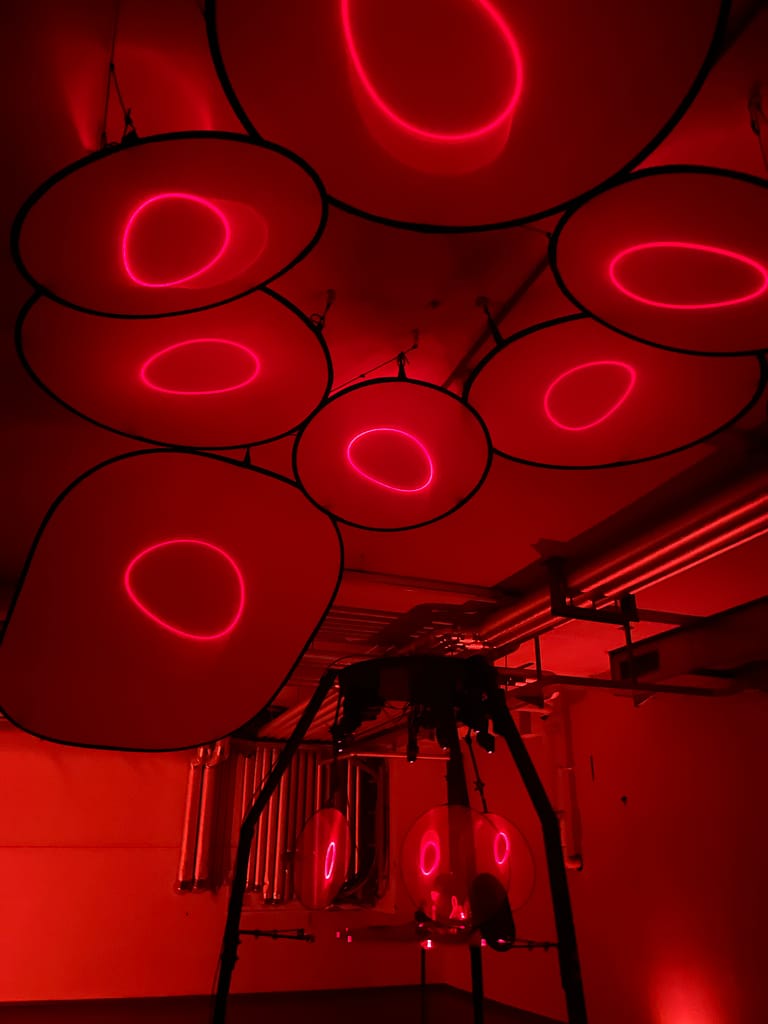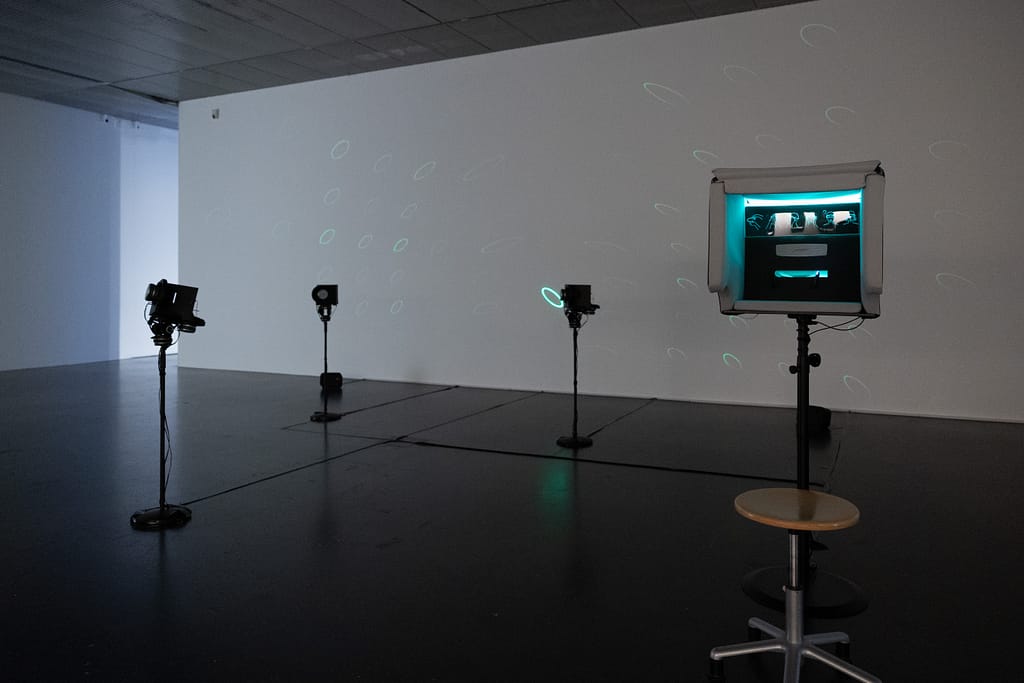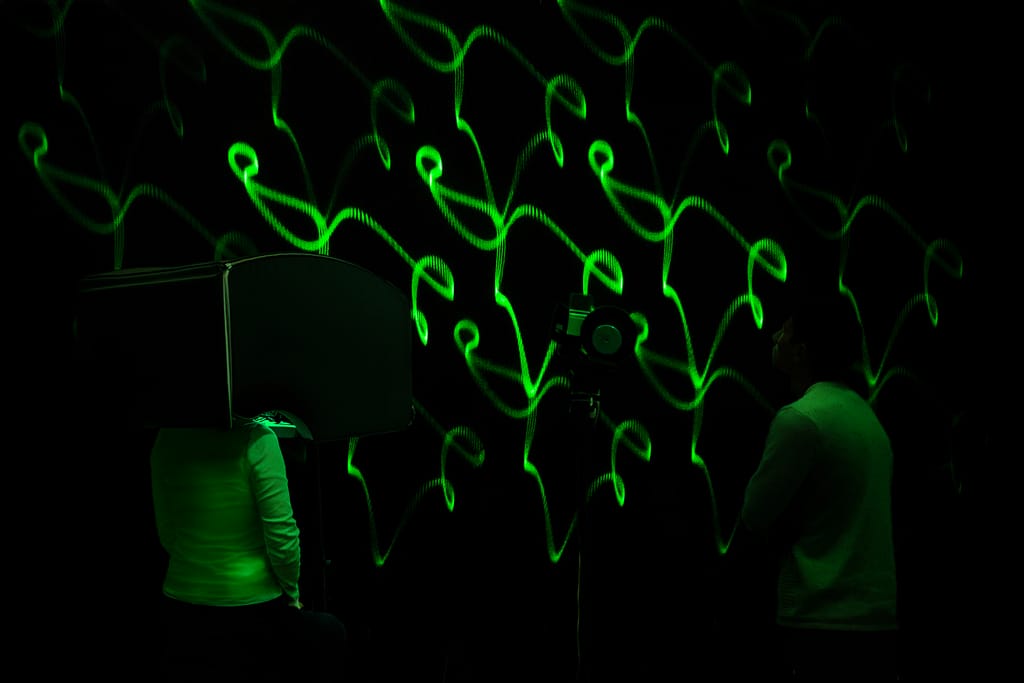ALBA TRIANA: FUNDAMENTAL INSIGNIA
By Patrick J. Reed
Alba Triana’s installation Harmonic Motion (2021) occupied a very dark room on the lowest level of the Ars Electronica Center in Linz, Austria, as part of Prix Ars Electronica, the world’s longest-running juried media art competition. The work had just received an Award of Distinction in the category of Digital Musics and Sound Art on the occasion of the 2023 Ars Electronica Festival and the right to appear with its contenders in a prestigious group show.
Harmonic Motion was isolated by necessity from the other “digital musics” sound pieces, artificial intelligence and life art, and so-called new animation. It demanded a margin of open space because it cast an enveloping red glow and emanated an equally enveloping hypnotic music. From its triangular foot, a three-legged armature upheld a ring of lasers at a height taller than the average adult male by several heads, and at its center stood a cymbal. The environment it produced would have felt mythological were it not by design explicable in scientific terms.

This is how it works: An electrical signal is automatically applied to the cymbal causing it to vibrate. No one touches the instrument; it is excited by the signal alone. The action is acoustic and physical. When activation happens, the cymbal’s vibrations are audible. Aided by a laser system pointed at the cymbal, these vibrations are also visible, their patterns translated onto reflective surfaces hanging from the ceiling. What is heard and what is seen constitute different ways in which the cymbal’s vibrations are perceptible during the work’s eight-and-a-half-minute cyclical composition, during which the electronic signal probes and, in a sense, narrates a small portion of the instrument’s sonic spectrum.1
In a festival-sponsored lecture, Triana remarked that Harmonic Motion distilled fifteen years of her artistic practice, a period that saw her transition from writing music for concert venues to creating immersive environments, kinetic sculptures, and installations for gallery spaces. The impetus for this change was nothing less than a drive to encounter and understand the foundational structure of the universe. “Everything in the natural world constantly vibrates,” she said, including the audible sounds, electromagnetism, and other forms of energy that have become her raw materials.2 Her artworks, rooted in an expanded definition of composition, explore and articulate this fact.
Vibrations are the great micro-macro common denominator. As Triana asserts, “these fundamental phenomena, within both living and inert entities, govern all levels of the natural structure—from atomic particles to biological elements, to society and the stars—and greatly determine who we are and what we manifest. […] The natural world [is] an indivisible whole that is intrinsically active, interconnected, ever-evolving, and self-organized. It suggests that our human condition is an expression of nature.” Articulating vibration’s omnipresence, Harmonic Motion, for example, “become[s] a vehicle to understand and most importantly to connect with one’s own essence, and the essence of everything.” It is a tool for accessing a deeper (arguably the deepest) meaning of existence that can be known. And, as a tool that leads to discovery, it belongs to a special order of revelatory technology that strives to blow your mind.2
Harmonic Motion reveals an abstract quotient of one’s self to oneself, the better to interrogate one’s relation to, quite literally, all else. Following Triana’s statement above regarding the essence of everything, it seems plausible to me, though I am speculating, that at certain levels beyond human attunement, the vibrations of the sculpture and the viewer synchronize to form their own entangled patterns, filigreed relations, and, perhaps not infrequently, oscillate in unison. The call to witness these fundamental insignia and contemplate the depth of being reached beyond the Prix Ars Electronica’s 2023 theme, “Who Owns the Truth?” That the festival furnished no definitive answer to its question is beside the point; Triana’s conceptual premise, from which Harmonic Motion was born, makes such questions moot; she is concerned with a primacy beyond the vagaries of truth and falsehood—that is, a principle subtending all things, without which concepts of truth and falsehood would not be possible.
The Italian philosopher Giorgio Agamben wrote, “Myth is the antidote to the word’s presumption to utter propositions that are solely true (or solely false). If what is at stake in a proposition is the idea, then it is impossible to demand that it be either true or false […]. The only discourse that is philosophical, Plato suggests, is a discourse that contains its own mythical complement, and can there proclaim both ‘the truth and falsity of being as a whole.’”3 So while Harmonic Motion does not function mythologically, it does engage the profundity of myth per Agamben, for it contains within itself and performs its own discourse on the unassailable idea of a vibrational, animating force operating beyond the jurisdiction of the true-false schema by which so much of the world is organized. In this way, Harmonic Motion establishes a cosmic attitude friendly to philosophy, if not explicitly philosophical.
Admittedly, the foregoing statement risks portraying the work’s purpose counter to the artist’s respect for music’s nonrepresentational authority. “I really believe in that abstract type of information that music deals with,” Triana told me while we sat together, chatting in the Ars Electronica Center’s food court. “I feel that we don’t need to always have a discourse. Music is powerful enough.”4 But just as Triana upends the definition of musical composition with her presentation and performance methods, so too can discourse assume connotations of nonverbal exchange like she finds “at the core of music and at the core of our human existence.”5 The term takes on primordial resonance.

Whereas Harmonic Motion communicated a basis for collective enmeshment, Triana’s other contribution to the 2023 festival program, Vibrant Self (2023), installed at the Lentos Kunstmuseum in Linz, called attention to the collective potential housed within the individual. Featured in the exhibition Dualities in Equalities: Art, Technology, Society in Latin America, a collaboration between Ars Electronica and the Cisneros Fontanals Art Foundation, Vibrant Self requested visitors to sit with their heads placed inside a console, where they heard a composition of sampled music and sounds from urban and natural environments, animals, and media documentation of public figures.6 While listening, visitors wore a brain-computer interface (BCI) headband that detected changes in brainwaves and head muscle responses. Through voltage fluctuations, the BCI captured the activity, which it analyzed and emitted as external, audible sound in the exhibition space, producing “an involuntary and subconscious performance for non-interacting visitors.”5
For this work, Triana again used a custom laser system to make the properties of vibrational phenomena visible. In this case, the modulated hum generated by the BCI was accompanied by an array of green laser waveforms that twisted and contorted across a long, white wall. The interacting visitor, whose reactions to the score informed the behavior of the visible waveforms in synch with their audible counterpart, was both instruments for and performer of the work. However, preoccupied by the act of listening, this visitor was unaware of the spectacle produced, an arrangement that lent an uncalculated quality to the scene. Basic neurological and physiological expression made “an essential reality […] manifest through the human body as mood, action, meaning, agenda, and ideology.”7 All factors contributing to the constitution of personhood were provoked by the audible score and relayed to the audience.

The interacting visitor’s broadcast, wholly abstract in character, signaled live responses to the audible score, which in turn prompted the passive visitors’ exposure to the installation’s projected audiovisuals. Links were forged between the interacting visitor and the audible score, the passive visitor and the installation’s stimuli, and by extension, between the interacting visitor and the passive onlooker. The mental intimacy of one became the shared intimacy of everyone in attendance. The audience was caught up in a momentary relationship-event unfolding in real time, never to be repeated, and made possible by the vibration’s universality. The binding element of this fleeting circumstance was the understanding that everyone is both instrument and receiver; the human condition resonates with every condition: we are resonating with our environment and its occupants, including each other; we are one within the great vibrations and infinitely more than ourselves. Vibrant Self simply enhanced the instrumentality of the interacting visitor to make the idea of these circumstances intelligible.
Recalling this equation with sensitivity proved challenging in the noisy Ars Electronica food court, among the clattering trays, caterwauling children, and other cafeteria racket. But with unwavering certainty, Triana affirmed the importance of her work. “I believe that we have the need to connect with our essence,” she said, “and we have different strategies [to do so]. There’s music. There’s meditation. There are rituals. I believe that connecting with our essence can help us expand our consciousness. And when we expand our consciousness, we really have a deeper understanding about our true role and position within this world.”4 Concluding our conversation, she excused herself from the table, leaving me to consider the truth at the center of her ideas, that elusive, capacious eternal standard likewise at the center of myth. A moment passed while she crossed the aisle and disappeared into the din, which I perceived anew as vibratory melee, chiming, whistling, and suffusing the whole of that cavernous room with its song.
ABOUT THE ARTIST
Alba Triana is a Miami-based composer and sound artist. She employs analog and digital technologies to explore the natural world’s fundamental structure and its manifestation through human constructions like art and music.
Triana has received the Prix Ars Electronica Award of Distinction (AT), Civitella-Ranieri Fellowship (IT/US), CIFO G&C Award, South Arts Fellowship (US). Her work has been showcased at Lowe Art Museum (US), Ars Electronica Festival (AT), NEMO—Biennale des Arts Numériques (FR), ISEA—International Symposium of Electronic Arts (WW), and Sónar+D (ES). Commissions, residences, and grants include Oolite Arts, Kronos Quartet (US), Pro-Helvetia (CH), Institut de Musique Électroacoustique de Bourges (FR), and Ministry of Culture (CO).
Her work is in numerous art collections, including CIFO, Mosquera, Junco (US), Otazu Foundation, Solo (ES), and Banco de la República (CO). She holds a double Master’s in Composition New Media/Integrated Media from the California Institute of the Arts (US).
In Fall 2024, Triana’s kinetic sculpture Music on a Bound String No. 2 (reflecting light) (2015) will be included in Energy Fields: Vibrations of the Pacific, an exhibition co-presented by Fulcrum Arts and Chapman University as part of the Getty-led initiative PST ART: Art & Science Collide.
—
All photos by Camilo Martin. Video courtesy of Alba Triana Studio.
- Alba Triana, “Prix Forum – Digital Musics & Sound Art: Harmonic Motion“(lecture, Ars Electronica: POSTCITY, Linz, Austria, September 10, 2023). [↩]
- Ibid. [↩] [↩]
- Giorgio Agamben, What I saw, heard, and learned…, trans. Alta L. Price. (London: Seagull Books, 2023). [↩]
- Alba Triana, in discussion with the author, September 10, 2023. [↩] [↩]
- Alba Triana, “Prix Forum – Digital Musics & Sound Art: Harmonic Motion” (lecture, Ars Electronica: POSTCITY, Linz, Austria, September 10, 2023). [↩] [↩]
- Founded in 2002, CIFO promotes Latin America contemporary art on the international stage. Triana was a recipient of a 2023 CIFO Award, thus her inclusion in Dualities in Equalities. More information about CIFO can be found at the foundation’s website: www.cifo.org. [↩]
- “Dualities in Equalities: Art, Technology, Society in Latin America,” Ars Electronica, accessed February 12, 2024, https://ars.electronica.art/who-owns-the-truth/en/cifo. [↩]